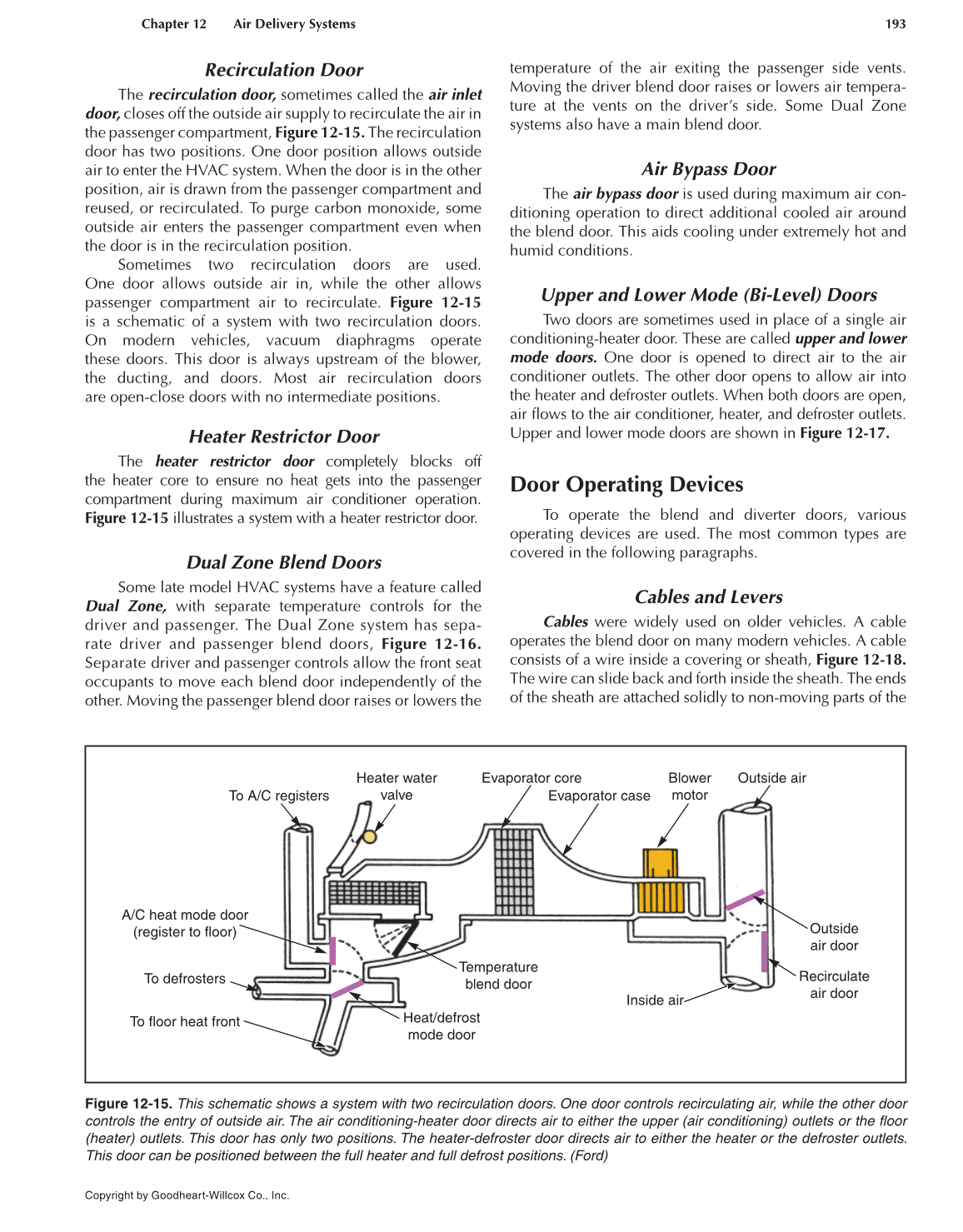Chapter 12 Air Delivery Systems 193
Copyright by Goodheart-Willcox Co., Inc.
Recirculation Door
The recirculation door, sometimes called the air inlet
door, closes off the outside air supply to recirculate the air in
the passenger compartment, Figure 12-15. The recirculation
door has two positions. One door position allows outside
air to enter the HVAC system. When the door is in the other
position, air is drawn from the passenger compartment and
reused, or recirculated. To purge carbon monoxide, some
outside air enters the passenger compartment even when
the door is in the recirculation position.
Sometimes two recirculation doors are used.
One door allows outside air in, while the other allows
passenger compartment air to recirculate. Figure 12-15
is a schematic of a system with two recirculation doors.
On modern vehicles, vacuum diaphragms operate
these doors. This door is always upstream of the blower,
the ducting, and doors. Most air recirculation doors
are open-close doors with no intermediate positions.
Heater Restrictor Door
The heater restrictor door completely blocks off
the heater core to ensure no heat gets into the passenger
compartment during maximum air conditioner operation.
Figure 12-15 illustrates a system with a heater restrictor door.
Dual Zone Blend Doors
Some late model HVAC systems have a feature called
Dual Zone, with separate temperature controls for the
driver and passenger. The Dual Zone system has sepa-
rate driver and passenger blend doors, Figure 12-16.
Separate driver and passenger controls allow the front seat
occupants to move each blend door independently of the
other. Moving the passenger blend door raises or lowers the
temperature of the air exiting the passenger side vents.
Moving the driver blend door raises or lowers air tempera-
ture at the vents on the driver’s side. Some Dual Zone
systems also have a main blend door.
Air Bypass Door
The air bypass door is used during maximum air con-
ditioning operation to direct additional cooled air around
the blend door. This aids cooling under extremely hot and
humid conditions.
Upper and Lower Mode (Bi-Level) Doors
Two doors are sometimes used in place of a single air
conditioning-heater door. These are called upper and lower
mode doors. One door is opened to direct air to the air
conditioner outlets. The other door opens to allow air into
the heater and defroster outlets. When both doors are open,
air fl ows to the air conditioner, heater, and defroster outlets.
Upper and lower mode doors are shown in Figure 12-17.
Door Operating Devices
To operate the blend and diverter doors, various
operating devices are used. The most common types are
covered in the following paragraphs.
Cables and Levers
Cables were widely used on older vehicles. A cable
operates the blend door on many modern vehicles. A cable
consists of a wire inside a covering or sheath, Figure 12-18.
The wire can slide back and forth inside the sheath. The ends
of the sheath are attached solidly to non-moving parts of the
Figure 12-15. This schematic shows a system with two recirculation doors. One door controls recirculating air, while the other door
controls the entry of outside air. The air conditioning-heater door directs air to either the upper (air conditioning) outlets or the fl oor
(heater) outlets. This door has only two positions. The heater-defroster door directs air to either the heater or the defroster outlets.
This door can be positioned between the full heater and full defrost positions. (Ford)
To A/C registers
Heater water
valve
Evaporator core
Evaporator case
Blower
motor
Outside air
A/C heat mode door
(register to floor)
To defrosters
To floor heat front
Heat/defrost
mode door
Temperature
blend door
Inside air
Recirculate
air door
Outside
air door
